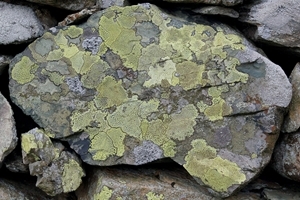Lichen
 Sometimes I sit down to write about a ‘species of the month’, knowing precious little about my chosen subject, but reckoning that it should make for an interesting little piece if I find out about it! Lichen is one such subject!
Sometimes I sit down to write about a ‘species of the month’, knowing precious little about my chosen subject, but reckoning that it should make for an interesting little piece if I find out about it! Lichen is one such subject!
Perhaps the first thing to say is that it is not just one species but, in fact, there are some 20,000 known species of lichen and it is estimated that 6% of the earth’s land surface is covered by them.
Put in its simplest form, lichens are made up of two living things: a fungus and an alga or bacteria. The fungus and the alga benefit from living together, as the alga produces food in the form of simple sugars through photosynthesis, while the fungus gathers water. In this way a lichen can survive harsh weather that would kill a fungus or an alga growing alone.
When lichens grow on living things such as trees, they are not parasitic on these plants, but only use them as a substrate to grow on. Indeed, they do not even have roots or require constant hydration, which is why lichens are able to grow in places that other plants cannot, such as deserts, mountaintops and frozen landscapes.
As lichens don’t have roots, they rely on taking in water and food from the atmosphere around them, which makes them extremely vulnerable to pollutants that have dissolved in rainwater.
Many species of lichen have become extinct due to increasing levels of sulphur dioxide since industrialisation, with others affected by ammonia from animal husbandry, atmospheric nitrogen oxides from exhaust fumes, and other pollutants such as ozone and fluorine.
While some species have seen a dramatic decrease in numbers, other species of lichen now have a wider range than they did a century ago – these species tend to have a higher tolerance to polluted air and survive in urban areas, growing on walls and pavements.
Lichens can be extremely long-lived, with some considered to be among the oldest living things on earth. Lichens grow slowly, with some only adding around 0.5mm per year. Some Antarctic lichens have estimated ages of up to 5,000 years old.
Despite growing so slowly, lichens can be amongst the first living things to grow on fresh rock exposed after an event such as a landslide. The long lifespan and slow and regular growth rate of some lichens can be used to date events, which is called lichenometry.
This all means that we can use lichens to determine many things, such as the length of time a habitat has been left undisturbed, or the effects of pollution and climate change.
I can’t really imagine eating lichen, but for reindeer it is an important food at a difficult time of year. The normal diet of a reindeer consists of ferns, grasses, mosses, and any other leaves or shoots they can find. However, these die back during the winter and are not available for the reindeer.
When their primary sources of food become scarce, reindeer turn to their alternate food, ‘reindeer lichen’, a common and relatively fast-growing lichen, found across northern temperate forests, boreal forests, and even in the tundra.
Over the winter, reindeer rely on reindeer lichen and a few other lichen species for roughly 90% of their food, with an adult reindeer having to eat 4-8kg of this food a day. Reindeer lichen is a good source of carbohydrates, which are extracted by special enzymes in the reindeers’ digestive system, but a poor source of protein. So even reindeer that eat their fill of lichens every day will still lose weight by the end of the winter.
Finally, there is a Harvard scientist who hopes to find clues to immortality by studying lichens! For the last decade, Anne Pringle, a mycologist, has been lurking about in cemeteries in order to keep tabs on the lichens that grow there.
Pringle’s preliminary results show that as lichens grow older and larger within these cemeteries, they are less likely to die. In the coming seasons, she plans on implementing more direct experiments with the hopes of confirming the lichens’ immortality within the span of her own life.
I find it somewhat ironic that she may answer some questions about immortality by studying the lichen on headstones of those who have long since departed this world!
Peter Thompson
Advisory
Read more from Peter Thompson at his blog.